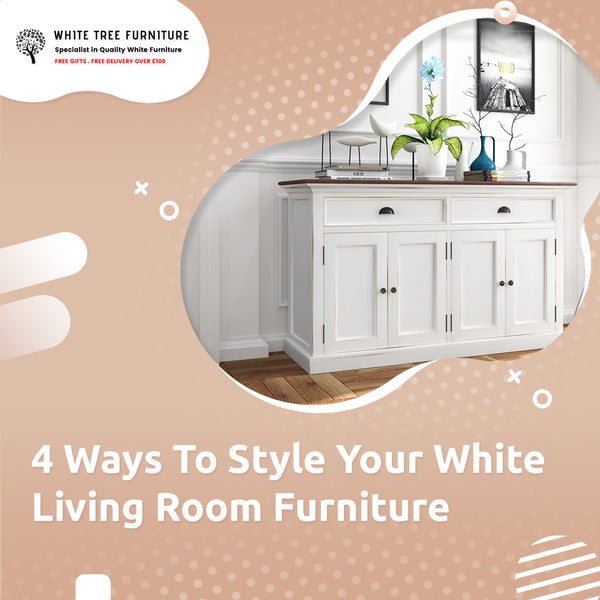Trying to decorate a new room in your home? Or are you selecting new pieces to give your white living room furniture a little sizzle for the new year? Chances are you’re considering a few major colors for your furniture pieces or wall paint. These are probably white, black, and wood brown.
However, mixing white and wood furniture together can be difficult. It may even seem tempting to stick with a general “white furniture” theme. At least that way, you'll know that all your pieces will gel together.
But mixing white and wood furniture together is a much better idea. You get a more complex space out of your furniture arrangement. But you’ll also get to be more creative with your design and color choices. Let’s break down how you can mix these furniture colors and types together successfully now.
Why is Mixing Wood and White Furniture Tricky?
Here’s the truth. White furniture gets its appearance from dyes. But wooden furniture is almost always some mixture of beige or brown hues. Many wooden furniture pieces have paint or finishes. But they still retain some of their original brown colorings most of the time.
So when you mix wood and white furniture, you usually end up combining bright white with earthy brown. The two colors can work, but if you do it improperly, you’ll make your room boring and bland.
Sometimes the colors of your furniture pieces can cause a space to blur together into a dull mess.
But the possible rewards can still make this well worth the effort. If you’re successful, you can create a warm, comfortable space that also feels open and inviting.
Mixing White and Wooden Furniture Like A Pro
When it comes to mixing white and wooden furniture, you should follow a few major design concepts. These should apply no matter which exact pieces you get or what shades of brown they are.
1. Choose a Dominant Tone to Start – White or Brown

Halifax Contrast Sideboard with Rattan Baskets
Every room in your home should have a dominant tone or color. Since we’re looking at wooden and white furniture, pick between these two extremes.
White-dominated rooms are typically quite airy and "open-feeling". In other words, they feel like they allow in more natural light even if there’s only a single window in the space. These rooms are also a little trickier to maintain. But you can keep white furniture white with the right preparation and good habits.
Wood or brown dominated rooms feel a little earthier, natural, and calm. This is especially true if the room utilizes multiple shades of brown at once.
Either way, be sure to choose one of these tones to stick with in general. Many people opt to stick with white as their dominant tone and progress to a cream shade over time. This is a common pick since most white furniture pieces have brown wooden legs.
2. Pro Tip – Follow the Tone of Your “Anchor” Piece

Halifax White Sideboard with 4 Rattan Baskets
Every room should also have a so-called anchor piece. The anchor piece is usually the largest piece of furniture in the room (and also usually wood). Examples include:
- entertainment centers
- coffee tables
- drink mixing stations
- cabinets
- speakers
- etc.
Focus on the anchor piece for a given room and you can use that piece as a kind of baseline for your overall aesthetic.
Say that your living room’s anchor piece is a large coffee table made of deep mahogany. In this case, you can use the mahogany shade (a dark brown) to dictate the color choices for the other pieces in the room.
3. Match the Undertones

Halifax Tall Cabinet with Glass Door (right) and Halifax Tall Narrow Bookcase with Drawer (left)
The undertones of given furniture pieces are the secondary colors in their compositions. For example, if you have a white sofa, white will obviously be the primary or major color.
But the same sofa might have an undertone of cream, beige, or even deeper brown based on the wooden leggings it has. Or maybe it has brown in its accents.
Take a moment and note the undertones of your existing and future furniture pieces. Match the undertones together as well as you can. By doing so, you’ll tie the room together in a subtle, impressive way that your guests may not even notice. In a good way, of course!
The undertones will work together to make all the furniture pieces appear to be part of the same style or set. This is true even if they are drastically different and in varying shades of white, cream, brown, and black.
4. Allow for Some Contrast

One big thing to avoid when mixing white and wooden furniture is blandness. If you aren’t careful, you might turn your room into a boring space without any character.
To alleviate this concern, try to go for high contrast pieces when possible.
Here’s an example:
- Say that you have a living room dominated by a brown couch and a brown small dining table
- You also have a white side table and lamp
- You might consider adding a darker wooden focal piece to the space. One good example might be a drink mixing station
- Add a piece of darker wood to the mix and you’ll draw the eye to that mixing station. This will cause guests to look around the space further, taking it all in consciously
You should also purposely try to contrast dark with light. Don’t try to create contrast by adding a boring light brown wooden piece to eggshell walls.
Go big or go home and choose a darker wooden piece whenever possible. Alternatively, pick a bright white piece if your room is dominated by dark browns and blacks.
Summary
Mixing white and wooden furniture together is a creative exercise you can use for any room in your home. White and wooden furniture gel a little more naturally than black and white. You don’t have to worry so much about high contrast making your room appear chaotic.
White and wooden furniture go together incredibly well overall. This is probably why it’s been a tried-and-true aesthetic for home décor for millennia. Remember to follow the above tips to the letter. Your next room decoration journey will be a blast!

